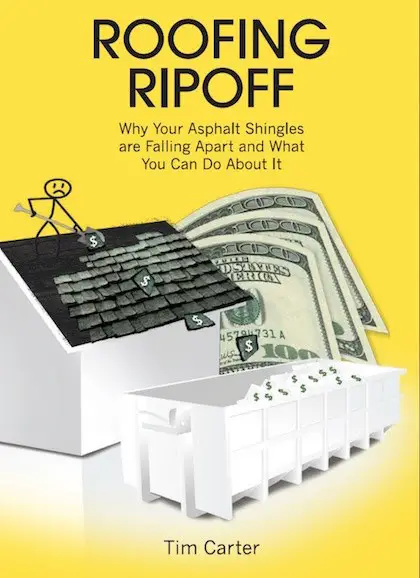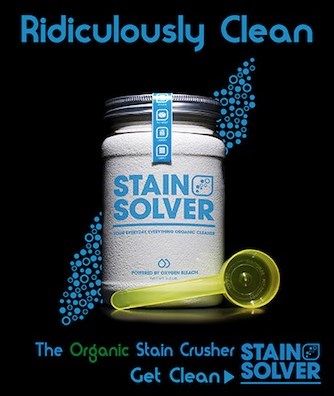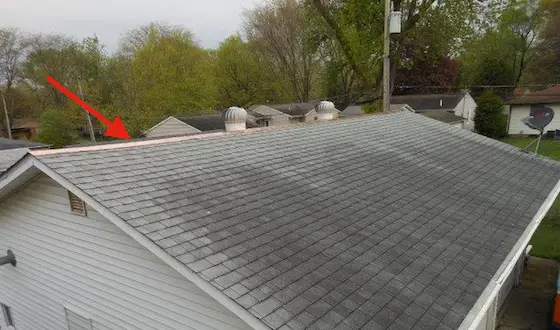Black Roof Stains

Much of this roof is covered with black cyanobacteria streaks. But two areas are not because of the metal that washes onto the roof each time it rains. Photo credit: Tim Carter
Black Roof Stains TIPS
- Microscopic algae causes the stains
- Algae is eating the limestone in the shingles
- Use Stain Solver certified oxygen bleach to clean
- Put up opens in a new windowcopper strips at ridge to STOP stains - LINK BELOW to get copper
- opens in a new windowCLICK HERE to Get Tim's FREE & FUNNY Newsletter!
DEAR TIM: My newer roof is turning black. It's got ugly black streaks that look like someone poured used motor oil on my roof. What's causing the problem?
Are the shingles defective? Is there a way to clean my roof and salvage it?
Once clean, is there a way to prevent the ugly stains? Carly S., Chilmark, MA
Ugly But No Harm
But don't worry, your roof will go bad long before the cyanobacteria, Gloeocapsa magma, stops gorging itself on the tasty shingles. The black stains are merely the dead cells of the tiny pesky microscopic creature. The algae doesn't hurt the shingles. It's just unsightly.
Water & Limestone = Blech!
The algae thrives in humid climates like yours. If you travel to just about any part of the USA that gets a fair amount of rainfall, you'll observe quite a few roofs sporting these horrid black streaks. Many houses have lots of roof visible from the ground so your pain is shared grief by many homeowners just like you.
Free & Fast Bids
The Backstory
The cause of the black streaks is quite an interesting story. Years ago shingles were made with felt paper as the base material. One of the ingredients of the felt paper was cotton. Cotton scraps from clothing factories were given or sold to shingle manufacturers.
The primary material was coarse wood fibers much like cardboard. The issue was this mat could only run through the shingle plant at about 300 feet per minute. Any faster and the paper would tear.

This is the cover of my Roofing Ripoff book. I cover in GREAT DETAIL in this book how shingles used to be made so there was NO STAINING or deterioration. CLICK THE IMAGE NOW TO ORDER IT.
Two Changes At Once
But in the 1970s there was an explosion of new synthetic fibers, like polyester, that started to flood into the clothing market. This meant fewer cotton scraps so the roofing product manufacturers had to scramble for a replacement material for the felt-paper base mat that made up the foundation of a typical shingle.
Fiberglass is what came to the rescue. A smaller Midwest shingle manufacturer decided to try to use fiberglass as a base mat and quickly discovered that the mill rollers could crank up to about 900 feet per minute without tearing. That's a HUGE INCREASE in productivity.
I clearly remember early in my career when fiberglass shingles hit the market. They were marketed as a revolutionary product, but the manufacturers were only telling part of the story.
Not Enough Weight
The manufacturers quickly discovered they had a problem using fiberglass. The thin mats wouldn't absorb enough asphalt to meet the minimum requirements of weight per square. It was decided the best way to add weight was to boost the amount of powdered limestone mixed with the liquid asphalt.
Powdered limestone had been used for decades before the 1970s, but in smaller amounts. It was needed to make the shingles stiffer so they could be handled on a warm day. Without the limestone, the shingles were like holding a cooked fettuccini noodle!
It worked. The shingles got up to weight much like a prize fighter.
Ruh Roh
However, the scientists at the shingle manufacturers didn't look around at limestone buildings down in the southern part of the USA. Most of them had black streaks.
If the scientists did look, they must have assumed it was dirt. It wasn't. It was our friend Gloeocapsa magma. It turns out this cyanobacteria loves to eat limestone.
Possible Defect
Your shingles may be defective, I just recently had to replace my own 30-year-guarantee asphalt shingles that only lasted 12 years, but believe me the roof algae is not the cause of deteriorating shingles or granule loss.
I wrote a revealing expose' book called opens in a new windowRoofing Ripoff that tells the truth about why asphalt shingles don't last as long as they used to and they stain faster.
Clean With Ease

Stain Solver is MADE in the USA with USA ingredients that are food-grade quality. CLICK THE IMAGE to order some NOW.
The good news is you can clean your roof and make it look like new. I've had great success using Stain Solver oxygen bleach.
IMPORTANT TIP: Do NOT use chlorine bleach as it will kill any vegetation that it comes into contact with around your home.
Watch the following video showing exactly how to use Stain Solver to clean algae from asphalt shingles.
Work in the morning in the cool part of the day.
The longer you let the Stain Solver soak and foam on the shingles, the LESS you have to scrub.
Clean Asphalt Shingles Video
The key is working on an overcast day with cool temperatures. If the shingles are HOT, the solution will evaporate before it can do any good.
Copper Coated Granules
A few decades after the new fiberglass shingles were brought to market and roofs started to turn black the manufacturers came out with a cure. They noticed that some roofs, or parts of them, were NOT turning black.
Anyplace above the roof where there was copper or zinc, the roof looked great. Copper produced better results than zinc.
This is nothing new as it's been known for hundreds of years that copper is a natural biocide. This is why copper plating was put on the hulls of many wooden clipper ships and warships to prevent barnacle growth that increased drag on the ships' hulls.
Copper is a great flashing material for roofs and each time it rains some of the copper atoms erode away and wash onto the roof killing the cyanobacteria.
Not Enough Though
You can purchase shingles that have copper in the colored granules, but some manufacturers skimp on the amount and there's not enough copper to give great results. I know as I had an asphalt shingle with algae-protection granules on my own garden shed that turned black within two years.
Install Copper Strips At Ridge
The best thing to do is to install strips of copper high up on your roof at the ridge line.

The black stains on this roof will disappear soon. This homeowner JUST INSTALLED the copper strip you can barely see at the peak of his roof. The red arrow points to it.
I'd leave at least 6 inches of copper exposed to ensure the black roof stains never appear again. The copper will weather quickly to a gorgeous nut-brown color adding a distinctive touch to your home.
Column 1095
6 Responses to Black Roof Stains